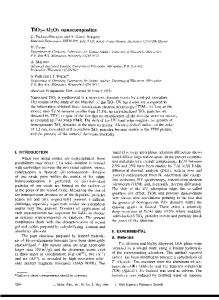Evaluation of Caffeine Degradation by Sequential Coupling of TiO 2 /O 3 /H 2 O 2 /UV Processes
- PDF / 2,668,945 Bytes
- 13 Pages / 595.276 x 790.866 pts Page_size
- 14 Downloads / 355 Views
ORIGINAL PAPER
Evaluation of Caffeine Degradation by Sequential Coupling of TiO2/O3/ H2O2/UV Processes Jose A. Lara‑Ramos1 · Gilmer D. Llanos‑Diaz1 · Jennyfer Diaz‑Angulo1,2 · Fiderman Machuca‑Martínez1
© Springer Science+Business Media, LLC, part of Springer Nature 2020
Abstract This study provides new insight into the implementation and synergy effect of coupling in sequences of the photocatalysis ([TiO2-UVC]), ozone (O3) and hydrogen peroxide ( H2O2) applied to degradation and mineralization of a model compound such as caffeine (in synthetic solution and industrial wastewater). The system consists of an annular photoreactor coupled to two venturi valves with a continuous dosage of O 3 and H 2O2, the combination of binary processes such as O 3/H2O2, TiO2/O3 and UVC/H2O2 was evaluated, as well as the coupling of TiO2/O3/H2O2/UVC in order to estimate all the possible synergy effects. It was found that the coupling between photocatalysis and hydrogen peroxide shows a negligible performance of caffeine treatment in both synthetic and real wastewater because the reaction rate, degradation and mineralization of caffeine does not improve considerably compared to the photocatalysis process alone. Meanwhile, the coupling between photocatalysis and ozonation shows the highest synergy effect. The coupling of all the processes evaluated TiO2/O3/H2O2/UVC achieved 100% degradation of caffeine, but the mineralization was lower than photocatalysis coupled with ozonation. This could be due to the peroxide and ozone compete by active sites of the catalyst and can also act as scavengers of oxidizing species, hindering the caffeine mineralization. The results show that the combination of photocatalysis with ozone and peroxide can make a synergy effect for industrial wastewater treatment. Keywords Photocatalysis · Ozonation · Industrial wastewater · Mineralization · Reaction rate · Synergy
1 Introduction Contaminants of emerging concern (CECs) are recalcitrant compounds present in different sources of water whose toxicity and persistence are capable of altering the metabolism of a living being [1]. CECs include micropollutants such as pharmaceuticals, pesticides, personal care products and industrial chemicals [2]. The main concern about these types of compounds is that wastewater treatment plants are unable to remove them [3]. Electronic supplementary material The online version of this article (https://doi.org/10.1007/s11244-020-01316-w) contains supplementary material, which is available to authorized users. * Fiderman Machuca‑Martínez [email protected] 1
Escuela de Ingeniería Química, Universidad del Valle, Ciudad Universitaria Meléndez‑A.A, 23360, Cali, Colombia
Research Group in Development of Materials and Products GIDEMP, CDT ASTIN SENA, Tecnoparque, Cali, Colombia
2
The reproductive decline, increased incidence of cancer, the development of antibiotic-resistant bacteria and the abnormal physiological processes in fishes are some of the possible risks from continued exposu
Data Loading...











